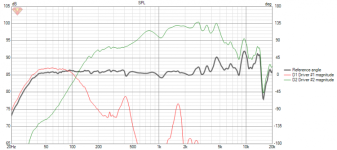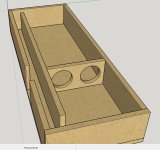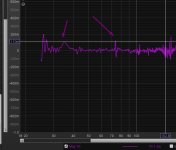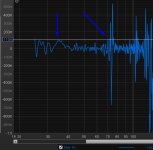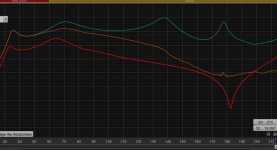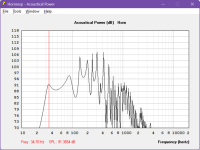Hi,
I would like to discuss a couple points regarding the port in case of 4th order bandpass subwoofer:-

1) How severe is the port resonance? The simulation shows a dip at about 180Hz, the reason why I ask is that I've read that simulation exaggerates it, it may actually not be such a deep null.
2) Can this slope before the first port resonance null (between 100Hz and 180Hz) be used as an acoustic crossover, the second peak is at 363Hz, I could always use a crossover (2nd order low pass ) at 200Hz only for that.
3) Is that peak at 363 Hz also exaggerated in simulation?
Warm Regards,
WonderfulAudio
I would like to discuss a couple points regarding the port in case of 4th order bandpass subwoofer:-
1) How severe is the port resonance? The simulation shows a dip at about 180Hz, the reason why I ask is that I've read that simulation exaggerates it, it may actually not be such a deep null.
2) Can this slope before the first port resonance null (between 100Hz and 180Hz) be used as an acoustic crossover, the second peak is at 363Hz, I could always use a crossover (2nd order low pass ) at 200Hz only for that.
3) Is that peak at 363 Hz also exaggerated in simulation?
Warm Regards,
WonderfulAudio
here a measurement of a Visaton 17cm bass in 4th order. Without crossover.
Looks good, but at least 6db filter needed for the bass
https://www.donhighend.de/?page_id=8974
Looks good, but at least 6db filter needed for the bass
https://www.donhighend.de/?page_id=8974
Attachments
I’m dumb…. Sorry. I saw ‘band pass’ and ‘ port resonace’ and got excited and posted my 6 th order parallel(not 4th….)
The full wave length gap before all the 1/4 wave junk as a crossover region is always intersting to me as well .
I did notice 345.6/meter/second /192hz is the full wave length of the entire enclosure (front to back of driver) of 180 cm?
…

The full wave length gap before all the 1/4 wave junk as a crossover region is always intersting to me as well .
I did notice 345.6/meter/second /192hz is the full wave length of the entire enclosure (front to back of driver) of 180 cm?
…
Last edited:
You don’t have a choice when you’re concerned with those resonaces because they conflict with your other speakers in the XO region
Or,
Build TL or higher order TL stuff and you’re dealing with a bunch of junk @ 3x Fb that must be addressed
Or,
Build TL or higher order TL stuff and you’re dealing with a bunch of junk @ 3x Fb that must be addressed
Last edited:
Using 48dB/octave filters to reduce out of band issues does introduce some other problems. I've tried them a few times and never could get the combined system to sound right.
^ Maybe the excess group delay is the reason? Higher order filters gives more phase offset and group delay. Best integration seems to be achieved when the different freq band drivers has equal phase offset at crossover frequency (first align time-of-flight = time delay for each driver.) Easiest done with DSP.
I tried to ‘fix’ the green high order qw bandpass box (roar) to go quiet like the red Helmholtz bandpass box does on its own acoustically and the group delay was goofy as heck.
I dunno what is worse, ringing pipe resonaces or lots of group delay. Or both 😱
These aren’t very useful subwoofers as the sound is to adultered with audible versions of fetanyl and methamphetamine 👽🚀
I dunno what is worse, ringing pipe resonaces or lots of group delay. Or both 😱
These aren’t very useful subwoofers as the sound is to adultered with audible versions of fetanyl and methamphetamine 👽🚀
Attachments
I have read group delay can be fixed with FIR-DSP. Don't know how, but must have something to do with a freq-dependent phase curve of opposite value?
I’m using cheap dayton dsp or equalizer APO on the laptop. Theres gotta be better ways to go about this than my amatuer/hobby level of nerding
If Equalizer APO can emulate an all-pass option, then it should be able to do the frequency-dependent phase shift. It's been a while since I've played around with Equalizer APO, so I can't remember if it can do it.
"Normal" filters can only add phase shift to the response, what Booger might need is something that could subtract phase shift. As I said, I really don't know how, but maybe CamillaDSP is able to handle such task? Then all ported designs could get rid of the nasty group delay smearing transients 🙂
Is it ‘more’ advantageous to try to create (acoustically) these big areas of cancellation in our subwoofer designs instead of trying to fill them in with messy stuff(horn shape instead of this ‘stepped’ resonator shape ) and then erasing it electronically?
Attachments
Last edited:
I would think so, a combination of electrical and acoustic filtering, then phase and delay adjusted with DSP. A bandpass design seems the easiest wrt acoustic filteringIs it ‘more’ advantageous to try to create (acoustically) these big areas of cancellation in our subwoofer designs instead of trying to fill them in with messy stuff(horn shape instead of this ‘stepped’ resonator shape ) and then erasing it electronically?
- Home
- Loudspeakers
- Subwoofers
- How severe is port resonance in 4th order bandpass?
